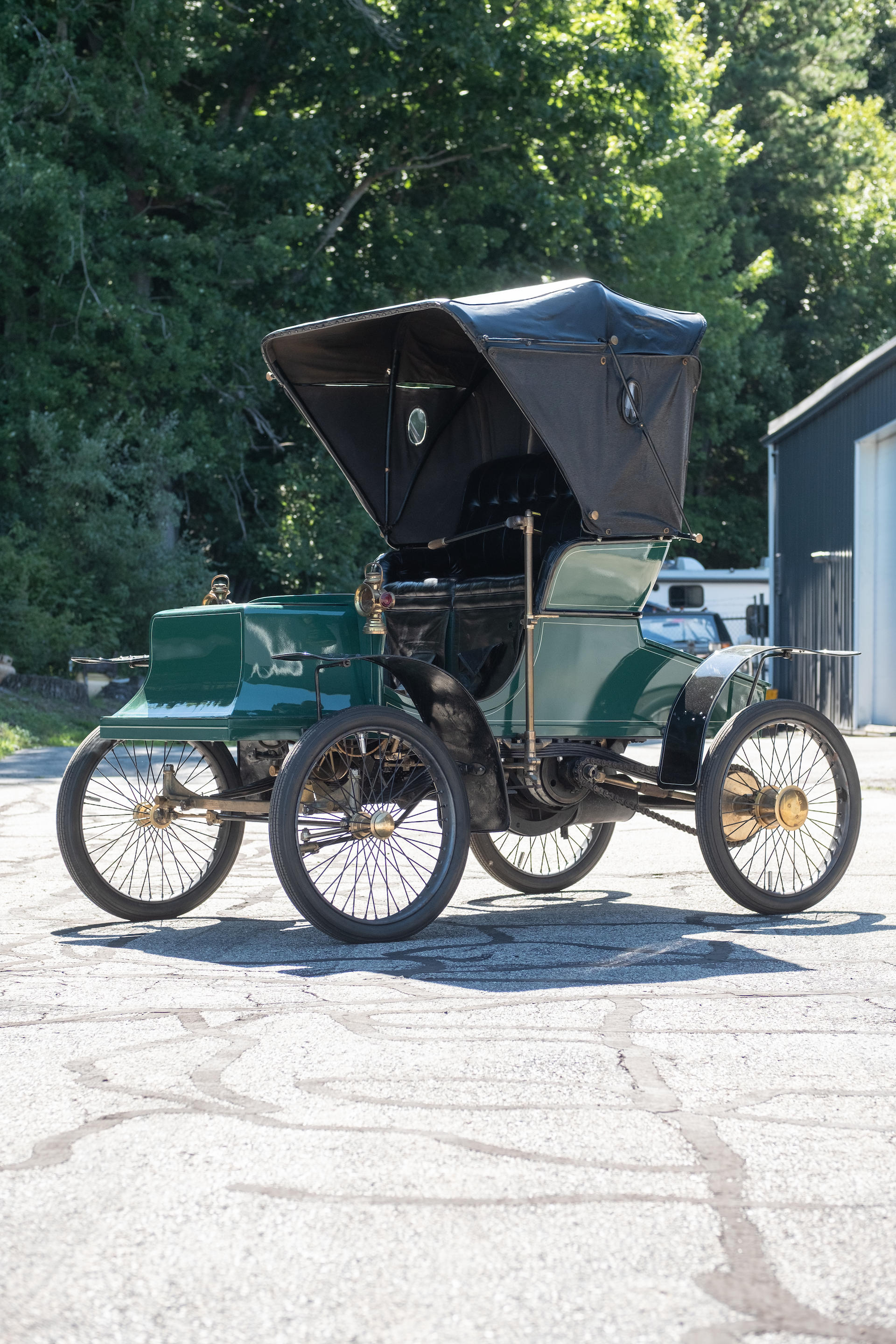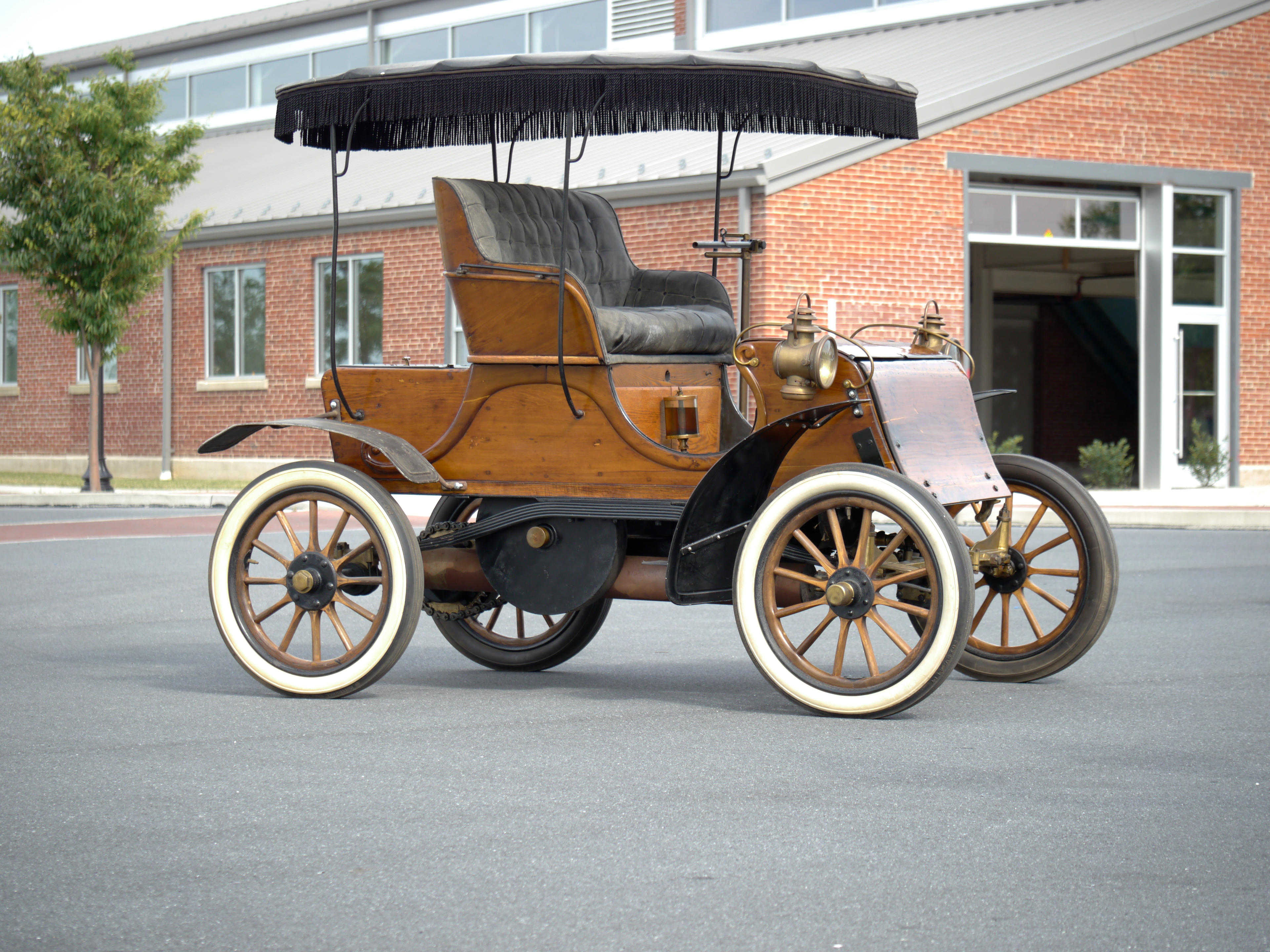157ci Air-Cooled Single Cylinder Engine 10bhp 2-Speed Manual Planetary Transmission Front and Rear Leaf Spring Suspension Rear Mechanical Brakes *Two owners from 1902 to 1973 *Long-term ownership by pioneering car collector Tom Sellers *Date certified by the VCC *Multiple London-to-Brighton run participant *Known ownership history from new The Model C In 1898, Harry A. Knox produced a light three-wheeled car, with a single-cylinder engine. For 1902, four-wheel models were added and both one- and two-cylinder engines were offered. In this period Knox engines were air cooled, causing them to be known as the Waterless Know, while the fact that their cylinder barrels were studded with 2-inch pins gave them a prickly appearance, causing some Knox owners to favor the nickname, "Old Porcupine," for their cars. The engine was mounted midships in the chassis and was connected to a 2-speed manual planetary transmission, driving the rear wheels through chains. A tiller provided steering from the car's left-side driving position. The Model C, built on a slightly extended wheelbase over its predecessor, featured clever, compact, runabout bodywork. The design and 72-inch wheelbase provided for the option of an additional two seats which folded out in front of the driver, a style frequently referred to as a 'Stanhope' on other contemporary vehicles of this era, and could arguably be thought of as the original '2+2'. A particularly appealing aspect to Knox coachwork is a molding which follows the contour of the body sides. The Motorcar Offered Knox identified their vehicles very simply by numbering the base of the 'porcupine' cylinder head, and on this car the number is found to be '11'. Of surviving examples, this places the car into the very beginning of the production sequence for 1902. Despite having a number of fantastic vehicle manufacturers near his home in Kokomo, Indiana, William Moore chose to buy a Knox from Massachusetts in 1901. Possibly purchased for his wife, this early Model C features a number of unique features, including babbitt bearings on the rear axles (later replaced with ball bearings). Kept by Mr Moore until 1929, it was then acquired by pioneering car collector Tom Sellers, also of Kokomo. Sellers was an active participant in the collector car hobby and news clippings from 1948 show him driving his 'Waterless Knox' in the Greentown, Indian 'Parade of 100 Years'. In an agreement with himself, Sellers always said he would sell his collection when he got to his 70s, so at age 73, in 1974. he auctioned everything off. Following his 1913 Pierce-Arrow Model 48, his Knox, which he had previously restored, was the star of the auction. Having had only two owners for its first 70+ years, the Knox moved through a series of three more owners before coming into the present family's collection in 1994. Refurbished shortly after acquisition, the car received its dating certificate from the Veteran Car Club of Great Britain, certification number 1823, in 1995. The Knox completed two successful London-to-Brighton Runs within a few years of the restoration. Today, the car's restoration has mellowed with age but still looks very presentable. An undeniably handsome Veteran automobile, this six-owners-from-new Knox will provide a potential four seater entry for Horseless Carriage Club events, or indeed the world famous London-to-Brighton Veteran Car Run in the UK.
157ci Air-Cooled Single Cylinder Engine 10bhp 2-Speed Manual Planetary Transmission Front and Rear Leaf Spring Suspension Rear Mechanical Brakes *Two owners from 1902 to 1973 *Long-term ownership by pioneering car collector Tom Sellers *Date certified by the VCC *Multiple London-to-Brighton run participant *Known ownership history from new The Model C In 1898, Harry A. Knox produced a light three-wheeled car, with a single-cylinder engine. For 1902, four-wheel models were added and both one- and two-cylinder engines were offered. In this period Knox engines were air cooled, causing them to be known as the Waterless Know, while the fact that their cylinder barrels were studded with 2-inch pins gave them a prickly appearance, causing some Knox owners to favor the nickname, "Old Porcupine," for their cars. The engine was mounted midships in the chassis and was connected to a 2-speed manual planetary transmission, driving the rear wheels through chains. A tiller provided steering from the car's left-side driving position. The Model C, built on a slightly extended wheelbase over its predecessor, featured clever, compact, runabout bodywork. The design and 72-inch wheelbase provided for the option of an additional two seats which folded out in front of the driver, a style frequently referred to as a 'Stanhope' on other contemporary vehicles of this era, and could arguably be thought of as the original '2+2'. A particularly appealing aspect to Knox coachwork is a molding which follows the contour of the body sides. The Motorcar Offered Knox identified their vehicles very simply by numbering the base of the 'porcupine' cylinder head, and on this car the number is found to be '11'. Of surviving examples, this places the car into the very beginning of the production sequence for 1902. Despite having a number of fantastic vehicle manufacturers near his home in Kokomo, Indiana, William Moore chose to buy a Knox from Massachusetts in 1901. Possibly purchased for his wife, this early Model C features a number of unique features, including babbitt bearings on the rear axles (later replaced with ball bearings). Kept by Mr Moore until 1929, it was then acquired by pioneering car collector Tom Sellers, also of Kokomo. Sellers was an active participant in the collector car hobby and news clippings from 1948 show him driving his 'Waterless Knox' in the Greentown, Indian 'Parade of 100 Years'. In an agreement with himself, Sellers always said he would sell his collection when he got to his 70s, so at age 73, in 1974. he auctioned everything off. Following his 1913 Pierce-Arrow Model 48, his Knox, which he had previously restored, was the star of the auction. Having had only two owners for its first 70+ years, the Knox moved through a series of three more owners before coming into the present family's collection in 1994. Refurbished shortly after acquisition, the car received its dating certificate from the Veteran Car Club of Great Britain, certification number 1823, in 1995. The Knox completed two successful London-to-Brighton Runs within a few years of the restoration. Today, the car's restoration has mellowed with age but still looks very presentable. An undeniably handsome Veteran automobile, this six-owners-from-new Knox will provide a potential four seater entry for Horseless Carriage Club events, or indeed the world famous London-to-Brighton Veteran Car Run in the UK.















Try LotSearch and its premium features for 7 days - without any costs!
Be notified automatically about new items in upcoming auctions.
Create an alert